Beaeve54
On this page, you find all documents, package deals, and flashcards offered by seller beaeve54.
- 1219
- 0
- 19
Community
- Followers
- Following
1 Reviews received
1238 items

NPTE-PTA: Neuromuscular Questions with correct answers
Asymmetrical Tonic Neck Reflex (ATNR): Normal Correct Answer - Stimulus: Head position, turned to one side Response: Arm and leg on face side are extended, arm and leg on scalp side are flexed, spine curved with convexity toward face side Normal age of response: Birth to 6 months Asymmetrical Tonic Neck Reflex (ATNR): Abnormal Correct Answer - Interferes with: Feeding Visual tracking Midline use of hands Bilateral hand use Rolling Development of crawling Can lead to skeletal deformit...
- Exam (elaborations)
- • 17 pages •
Asymmetrical Tonic Neck Reflex (ATNR): Normal Correct Answer - Stimulus: Head position, turned to one side Response: Arm and leg on face side are extended, arm and leg on scalp side are flexed, spine curved with convexity toward face side Normal age of response: Birth to 6 months Asymmetrical Tonic Neck Reflex (ATNR): Abnormal Correct Answer - Interferes with: Feeding Visual tracking Midline use of hands Bilateral hand use Rolling Development of crawling Can lead to skeletal deformit...
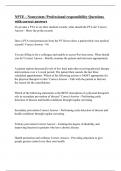
NPTE - Nonsystem /Professional responsibility Questions with correct answers
If a pt asks a PTA to see their medical records, what should the PTA do? Correct Answer - Show the pt the records Does a PTA need permission from the PT first to show a patient their own medical records? Correct Answer - No You are filling in for a colleague and unable to access Previous notes. What should you do? Correct Answer - Briefly examine the patient and intervene appropriately A patient reports decreased levels of low back pain after receiving physical therapy interventions ove...
- Exam (elaborations)
- • 6 pages •
If a pt asks a PTA to see their medical records, what should the PTA do? Correct Answer - Show the pt the records Does a PTA need permission from the PT first to show a patient their own medical records? Correct Answer - No You are filling in for a colleague and unable to access Previous notes. What should you do? Correct Answer - Briefly examine the patient and intervene appropriately A patient reports decreased levels of low back pain after receiving physical therapy interventions ove...
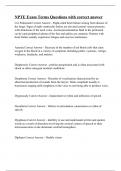
NPTE Exam Terms Questions with correct answer
Cor Pulmonale Correct Answer - Right-sided heart failure arising from disease of the lungs. Signs of right ventricular failure are elevated central venous pressure with distension of the neck veins. Ascites(accumulation fluid in the peritoneal cavity) and peripheral edema of the feet and ankles are common. Patients with heart failure usually experience fatigue and exercise intolerance Anemia Correct Answer - Decrease in the number of red blood cells that carry oxygen in the blood in a variety...
- Exam (elaborations)
- • 56 pages •
Cor Pulmonale Correct Answer - Right-sided heart failure arising from disease of the lungs. Signs of right ventricular failure are elevated central venous pressure with distension of the neck veins. Ascites(accumulation fluid in the peritoneal cavity) and peripheral edema of the feet and ankles are common. Patients with heart failure usually experience fatigue and exercise intolerance Anemia Correct Answer - Decrease in the number of red blood cells that carry oxygen in the blood in a variety...
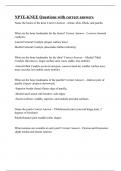
NPTE-KNEE Questions with correct answers
Name the bones of the knee Correct Answer - femur, tibia, fibula, and patella What are the bony landmarks for the femur? Correct Answer - 2 convex femoral condyles: Lateral Femoral Condyle (longer surface area) Medial Femoral Condyle (descendes farther inferioly) What are the bony landmarks for the tibia? Correct Answer - -Medial Tibial Condyle (biconcave, larger surface area, more stable, less mobile) -Lateral tibial Condyle (convex/ant-post, concave/med-lat, smaller surface area, more...
- Exam (elaborations)
- • 17 pages •
Name the bones of the knee Correct Answer - femur, tibia, fibula, and patella What are the bony landmarks for the femur? Correct Answer - 2 convex femoral condyles: Lateral Femoral Condyle (longer surface area) Medial Femoral Condyle (descendes farther inferioly) What are the bony landmarks for the tibia? Correct Answer - -Medial Tibial Condyle (biconcave, larger surface area, more stable, less mobile) -Lateral tibial Condyle (convex/ant-post, concave/med-lat, smaller surface area, more...
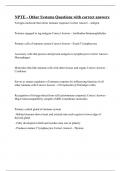
NPTE - Other Systems Questions with correct answers
Foreigns molecule that elicits immune response Correct Answer - Antigen Proteins engaged to tag antigens Correct Answer - Antibodies/Immunoglobulins Primary cells of immune system Correct Answer - B and T lymphocytes Accessory cells that process and present antigens to lymphocytes Correct Answer - Macrophages Molecules that link immune cells with other tissues and organs Correct Answer - Cytokines Serves as master regulators of immune response by influencing function of all other ...
- Exam (elaborations)
- • 37 pages •
Foreigns molecule that elicits immune response Correct Answer - Antigen Proteins engaged to tag antigens Correct Answer - Antibodies/Immunoglobulins Primary cells of immune system Correct Answer - B and T lymphocytes Accessory cells that process and present antigens to lymphocytes Correct Answer - Macrophages Molecules that link immune cells with other tissues and organs Correct Answer - Cytokines Serves as master regulators of immune response by influencing function of all other ...
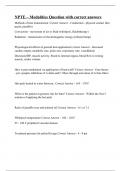
NPTE – Modalities Question with correct answers
Methods of heat transmission: Correct Answer - Conduction - physical contact (hot packs, paraffin) Convection - movement of air or fluid (whirlpool, fluidotherapy) Radiation - transmission of electromagnetic energy (infrared lamp) Physiologocial effects of general heat application Correct Answer - Increased cardiac output, metabolic rate, pulse rate, respiratory rate, vasodilation Decreased BP, muscle activity, blood to internal organs, blood flow to resting muscle, stroke volume How is...
- Exam (elaborations)
- • 10 pages •
Methods of heat transmission: Correct Answer - Conduction - physical contact (hot packs, paraffin) Convection - movement of air or fluid (whirlpool, fluidotherapy) Radiation - transmission of electromagnetic energy (infrared lamp) Physiologocial effects of general heat application Correct Answer - Increased cardiac output, metabolic rate, pulse rate, respiratory rate, vasodilation Decreased BP, muscle activity, blood to internal organs, blood flow to resting muscle, stroke volume How is...
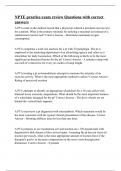
NPTE practice exam review Questions with correct answers
A PTA reads in the medical record that a physician ordered a maximal exercise test for a patient. What is the primary rationale for utilizing a maximal test instead of a submaximal exercise test? Correct Answer - Determine maximum oxygen consumption. A PTA completes a work site analysis for a pt with T3 paraplegia. The pt is employed in the marketing department of an advertising agency and relies on a wheelchair for daily locomotion. Which of the following is likely to be the most significant...
- Exam (elaborations)
- • 11 pages •
A PTA reads in the medical record that a physician ordered a maximal exercise test for a patient. What is the primary rationale for utilizing a maximal test instead of a submaximal exercise test? Correct Answer - Determine maximum oxygen consumption. A PTA completes a work site analysis for a pt with T3 paraplegia. The pt is employed in the marketing department of an advertising agency and relies on a wheelchair for daily locomotion. Which of the following is likely to be the most significant...
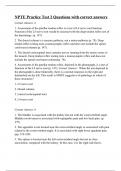
NPTE Practice Test 2 Questions with correct answers
Correct Answer: 4 1. Assessment of the patellar tendon reflex is a test of L4 nerve root function. Function of the L5 nerve root would be assessed with the deep tendon reflex test of the hamstrings. (p. 147) 2. The dorsal column is a sensory pathway, not a motor pathway (p. 78). Deep tendon reflex testing tests a monosynaptic reflex and does not include the spinal cord tracts/columns (p. 147). 3. The lateral corticospinal tract contains nerves running from the motor cortex to the muscle. Deep...
- Exam (elaborations)
- • 169 pages •
Correct Answer: 4 1. Assessment of the patellar tendon reflex is a test of L4 nerve root function. Function of the L5 nerve root would be assessed with the deep tendon reflex test of the hamstrings. (p. 147) 2. The dorsal column is a sensory pathway, not a motor pathway (p. 78). Deep tendon reflex testing tests a monosynaptic reflex and does not include the spinal cord tracts/columns (p. 147). 3. The lateral corticospinal tract contains nerves running from the motor cortex to the muscle. Deep...
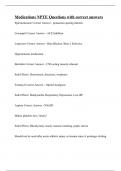
Medications NPTE Questions with correct answers
Spironolactone Correct Answer - potassium sparing diuretic Lisionpril Correct Answer - ACE Inhibitor Lopressor Correct Answer - Beta Blocker, Beta-1 Selective Hypertension medication Baclofen Correct Answer - CNS acting muscle relaxant Side Effects: Drowsiness, dizziness, weakness Fentanyl Correct Answer - Opioid Analgesic Side Effects: Bradycardia, Respiratory Depression, Low BP Aspirin Correct Answer - NSAID Makes platelets less "sticky" Side Effects: Bloody/tar...
- Exam (elaborations)
- • 10 pages •
Spironolactone Correct Answer - potassium sparing diuretic Lisionpril Correct Answer - ACE Inhibitor Lopressor Correct Answer - Beta Blocker, Beta-1 Selective Hypertension medication Baclofen Correct Answer - CNS acting muscle relaxant Side Effects: Drowsiness, dizziness, weakness Fentanyl Correct Answer - Opioid Analgesic Side Effects: Bradycardia, Respiratory Depression, Low BP Aspirin Correct Answer - NSAID Makes platelets less "sticky" Side Effects: Bloody/tar...
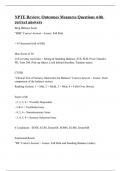
NPTE Review: Outcomes Measures Questions with correct answers
Berg Balance Scale "BBS" Correct Answer - Assess: Fall Risk < 45 Increased risk of falls Max Score of 56 14 Everyday Activities = Sitting & Standing Balance, STS, SLB, Pivot Transfer, FR, Turn 360, Pick up object, Look behind shoulder, Tandem stance CTSIB "Clinical Test of Sensory Interaction for Balance" Correct Answer - Assess: Each component of the balance system Ranking System: 1 = Min, 2 = Mold, 3 = Mod, 4 = Falls Over (Sway) Issues with: - 2, 3, 5, 6 = Visua...
- Exam (elaborations)
- • 29 pages •
Berg Balance Scale "BBS" Correct Answer - Assess: Fall Risk < 45 Increased risk of falls Max Score of 56 14 Everyday Activities = Sitting & Standing Balance, STS, SLB, Pivot Transfer, FR, Turn 360, Pick up object, Look behind shoulder, Tandem stance CTSIB "Clinical Test of Sensory Interaction for Balance" Correct Answer - Assess: Each component of the balance system Ranking System: 1 = Min, 2 = Mold, 3 = Mod, 4 = Falls Over (Sway) Issues with: - 2, 3, 5, 6 = Visua...

6005 Mental Health ATI Questions with correct answers